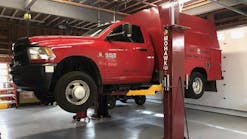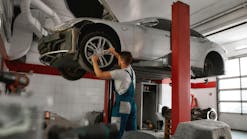How do you fix cars when you can’t get parts? I wish this were just a philosophical question, the kind usually reserved for falling trees in the woods or a single hand clapping, but instead, it’s the reality that shop owners continue to face. When the supply chain is disrupted from manufacturing to distribution and every step in between, shops are forced to answer this question.
The answers to this question aren’t pretty. And the array of bad choices that many shop owners are forced to select from points the finger at some of the biggest problems facing the independent auto repair industry.
But before we dig into all of that, let’s tackle my opening question head-on: if, like most shop owners, you regularly have problems finding parts for the vehicles you’re fixing, what are your options? How do you fix cars when you can’t get parts?
Don't fix the cars?
The first option, of course, is don’t — don’t fix the cars! Continue to order parts as you always have. This is what a lot of shops are doing, so you’ll have plenty of company.
Of course, the days of waiting a few hours for parts are long past. Across North America, the trend is to wait for a day, two days, or even more sometimes. And so, the car that could have been repaired today gets pushed to tomorrow, or the next day, or the next week. And the customer who could have had their vehicle inspected today in that open bay gets pushed out further and further.
Slowly, your pipeline gets restricted. One fewer car per day for that tech. Five fewer per week. Twenty per month. Longer appointment wait times, decreased car count, lower sales.
This is how a boa constrictor kills, for what it’s worth. Every time the prey exhales, the snake squeezes a little tighter, so that there’s less and less air filling its lungs.
There’s a better way.
The only real way to fight strangulation by part-sourcing is to do the research. Which vendors have the part in stock right now? Who can get it to me the fastest? Where’s the balance in price and speed?
It’s not that simple for most shops. Sure, it sounds good when all you have to do is take a few extra minutes to find the right part so that we can fix that car today and get paid.
But that’s a fantasy world! Here in the real world, that research isn’t a few minutes. It’s 15 minutes with one vendor, and then 20 minutes on hold with another just to find out they’ll call you back later. Add it all up, and we’re talking hours of time being destroyed for the people whose job it is to keep all your tickets moving. They’re losing time on each part, yes, but that pushes the calls they make to get work approved from the morning to the afternoon where they’ll never close as many jobs.
All of this means the shop is no longer suffocating, sure, but bleeding to death internally isn’t much of an alternative.
This is the horrible position shop owners find themselves in. Do you ignore the problem and hope to survive? Or do you throw manpower at the problem and let the drop in efficiency kill the shop instead?
These are bad choices, and they are the result of repair shop owners getting a raw deal over and over and over.
They are the result of dealerships fighting to make it harder for you to get parts. They are a result of government manipulation of supply chains. And frankly, these are the lousy choices that most owners are deciding between because of the way our industry operates. Do I lose $5,000 in potential work, or do I lose $25,000? Either way, I lose.
By now, you probably have an option for sourcing parts in your shop management system. This is a major step up from having to call each vendor individually, and a step further still from having to look up each part on the website of each vendor.
But have you ever wondered why the part sourcing inside most shop management systems is remarkably similar? Why it forces you down this inefficient path of having to spend many minutes for every single little part to find one that’ll get here quickly for a reasonable cost? So that then you can get busy finding the other six parts you need for that repair order, one at a time?
These circumstances exist for a reason: it makes other people very wealthy. The larger, old-school corporations that control most of your software and things you’re doing today benefit greatly from these conditions. They work hard to create lemmings who believe things could never be better than they are right now because you’re already doing just as well as your competition down the street.
And so everywhere we look, we see shop owners being sold the idea that the mediocre is good enough.
Marketing companies will sell you cheap pieces that look like everyone else’s because it helps them. When that piece drives discount shoppers who can’t tell a difference between you and your competition, it does not matter to them.
20 groups draw in owners from all over the country with the comfort of a mediocre middle because it benefits them. The fact that the group is specifically designed to help each member reach an average middle where nobody can truly excel does not matter to them.
Some business coaches are repeating the mantra, “You just need a coach; it doesn’t matter who,” because it benefits them. The lack of accountability or sustained success for the shops using that coaching does not matter to those coaches.
This isn’t how top shops operate.
If you want to be a part of the one percent, you can’t do what the other 99 percent are doing. If you want to be a top shop operator, you cannot do what mediocre shop owners are doing. You cannot stay in your comfort zone and ever hope to achieve real success.
The way to grow and succeed as a repair shop is to set yourself apart. This encompasses every part of shop ownership. The paint on the walls, the decoration in the waiting room, the people you hire, the marketing you send, the software you use, the processes you trust. Each of those is your opportunity to be smarter, more efficient, more profitable, to take better care of customers, and build stronger, more loyal relationships.
And yes, to demand a better way to run your shop.
The current parts supply issues are only the latest bad card that has been dealt to shop owners. The hand we’re holding already includes a devastating tech shortage, inflation, recession, and more. And yet the tune that so much of our industry keeps singing sounds a lot like “we’ve tried nothing and we’re all out of ideas.”
You deserve better.
The next time you’re forced to choose between suffocation or internal hemorrhaging, choose the third option. Stop accepting mediocrity and demand better for your shop. You’ve worked too hard, sacrificed too much, and taken too big a risk to accept the lesser evil as your only choice.
It starts with you demanding more, though, and setting the example. You have to set yourself apart, and work with businesses on that same mission. You have to reject the status quo and this notion that just because most people do it that way it must be right.
The rewards speak for themselves. Shops that set themselves apart — including ours — grew massively during COVID. We had clients who doubled their sales during COVID and have doubled again since. These are shop owners who finally built the business they dreamed of.
They didn’t get there by following the crowd or by accepting mediocrity. They did it by demanding more – of themselves, of their vendors, of the products and services they bought, and of the industry around them.
This can be yours, too. But you need to stop accepting less than the best, stop making half-baked attempts, and, above all, stop justifying it!
Download a free guide for fighting against mediocre shop management solutions at grow.shop4d.com/fight.



